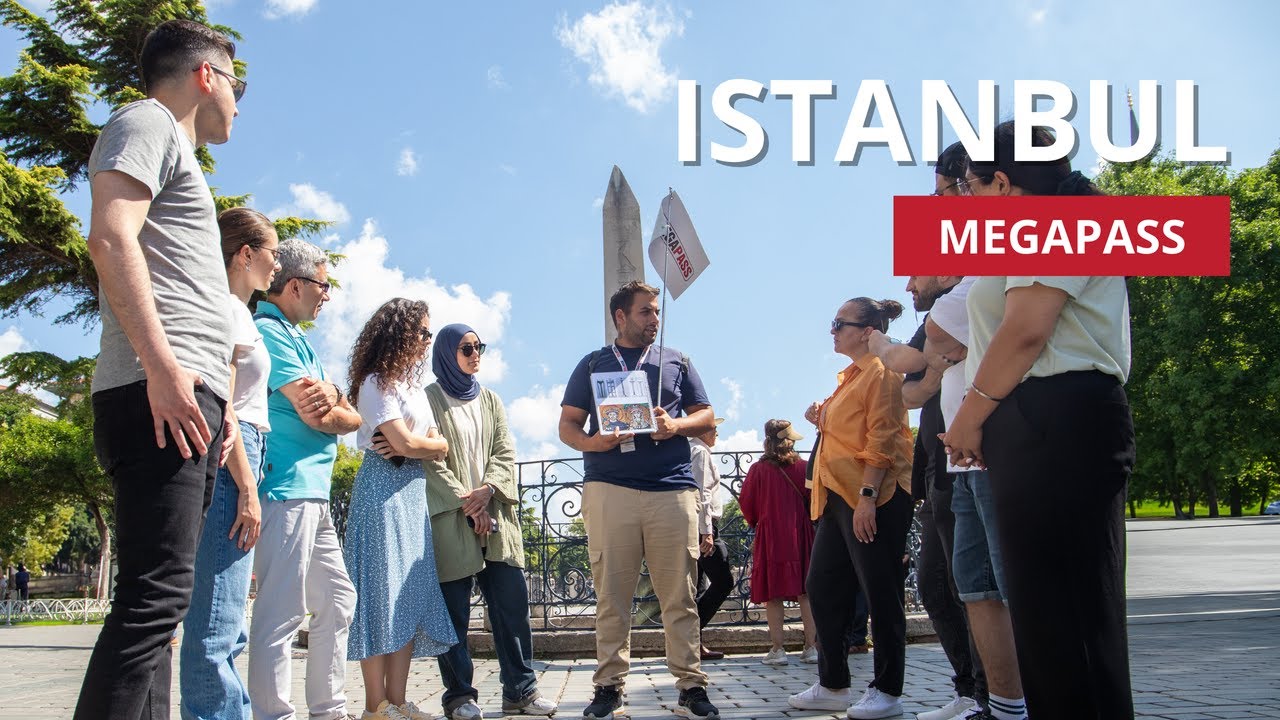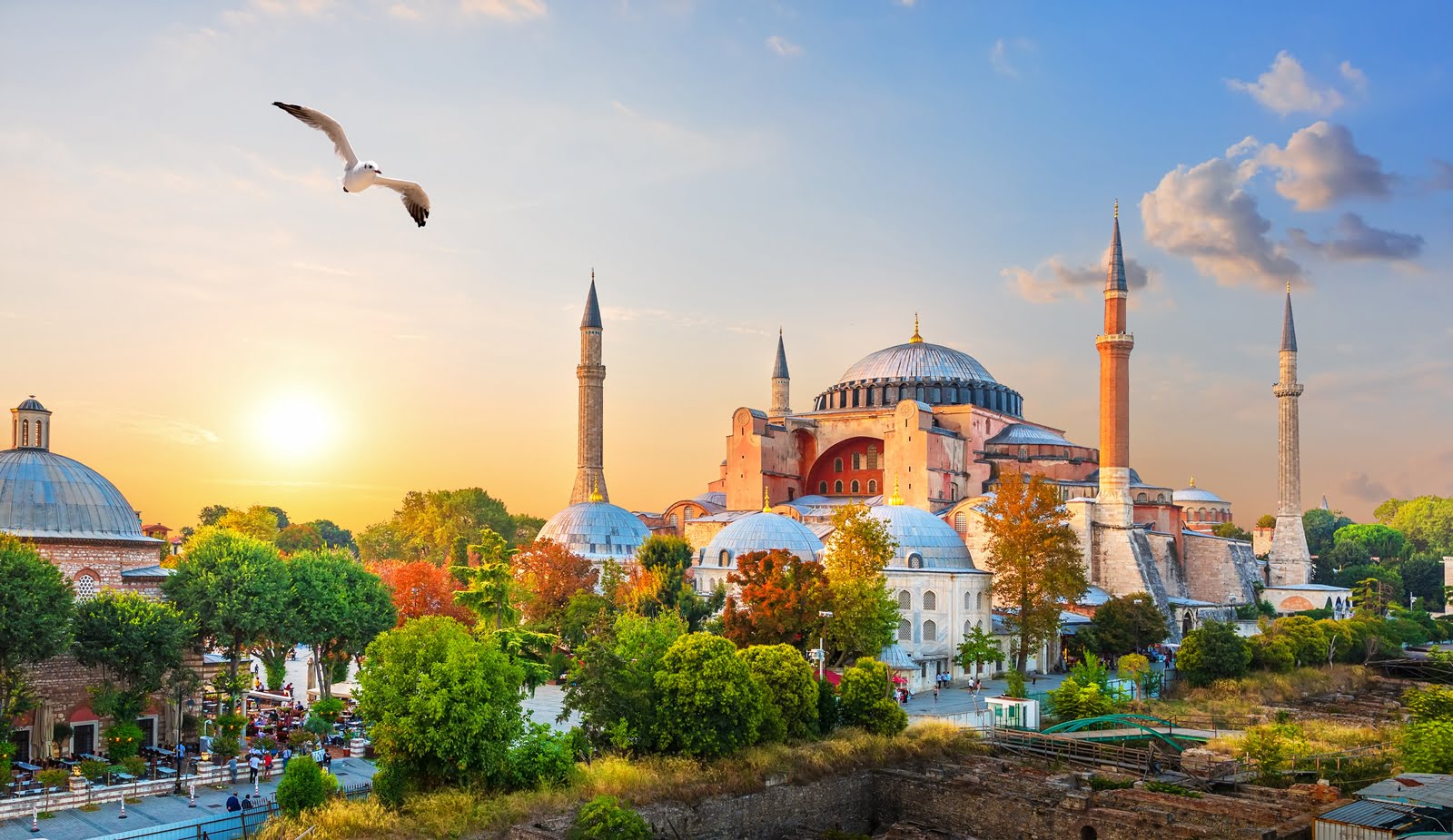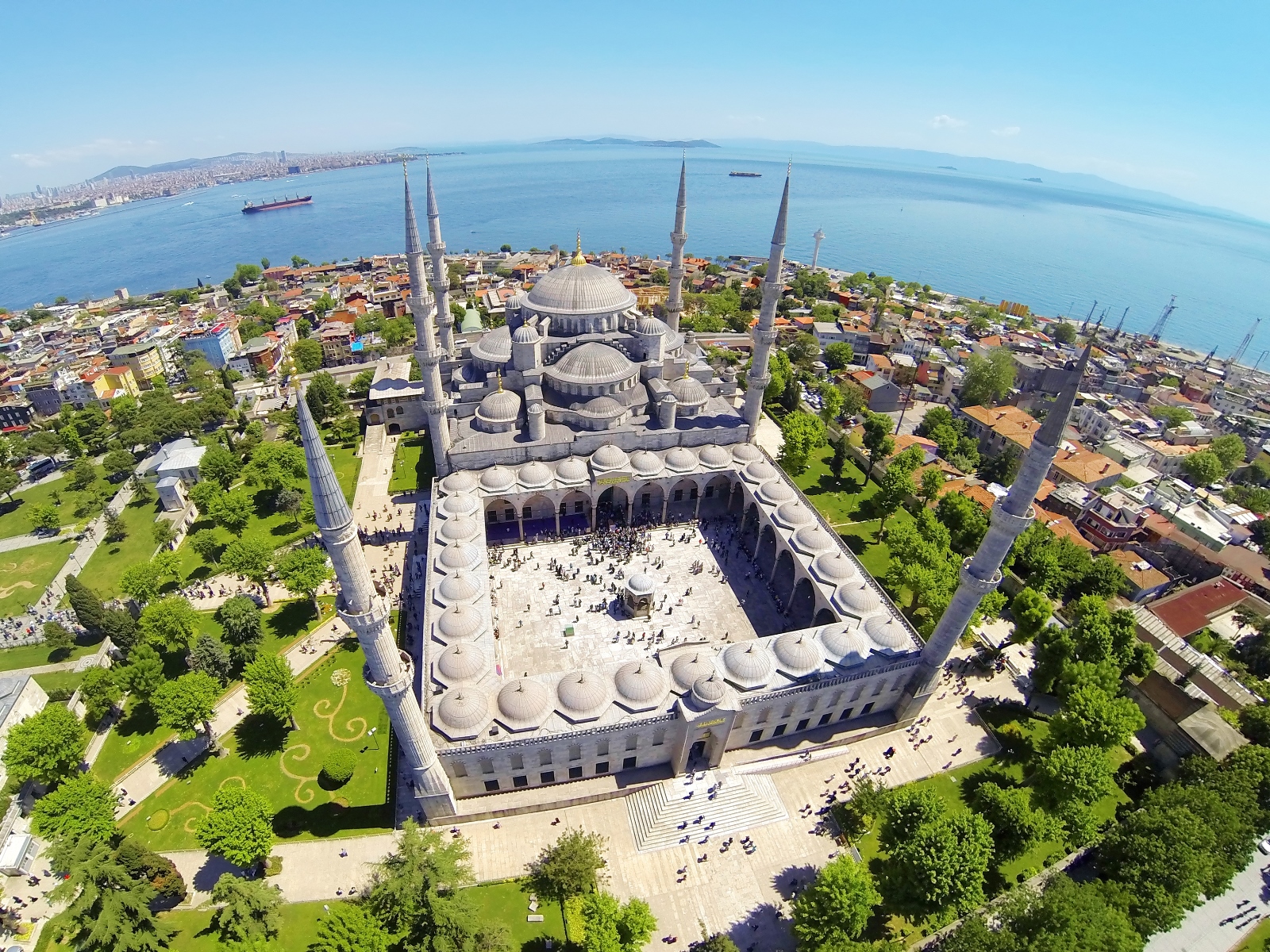There is something quiet and unexpected about your first steps into the Basilica Cistern Istanbul. The air cools. The light softens. And suddenly you’re surrounded by hundreds of ancient columns rising out of still, black water. Most travelers know about the famous Medusa heads, yet the moment that really catches you arrives earlier: that first glimpse of orange reflections stretching across the floor like a watercolor painting.
According to recent visitor discussions on TripAdvisor, this is the part that feels almost surreal because it is nothing like the bright, open spaces of Hagia Sophia or Topkapi. It is darker, slower and strangely calming.
Many first time visitors arrive without realizing that the cistern you see in 2026 is the result of a massive restoration completed only a few years ago. The old concrete walkways are gone. Lighting is richer and more theatrical. The columns feel more present.
And the entire structure carries a sense of intimacy that guides often describe as Istanbul’s most atmospheric underground space. We have seen travelers who normally rush through museums slow down here. The space asks for it.
Our guide is written for travelers who want the complete picture without wading through outdated posts. We bring what visitors repeatedly ask online: how long a visit really takes, how to avoid lines, whether skip the line tickets are worth it, if the Basilica Cistern tickets sold on-site differ from online options, and what time of day feels the most magical.
According to official information from Yerebatan Sarnıcı’s management, updates continue to shape the visitor experience, which is why 2026 planning looks slightly different than guides written pre-restoration.
If you want a visit that feels smooth instead of stressful and unforgettable instead of rushed, understanding how the cistern works today is the best place to start.
5 Fascinating Fast Facts About Basilica Cistern
The Basilica Cistern (“Yerebatan” in Turkish, which means “sinking to the ground”), serving a museum now, is one of the most impressive and mystical buildings in Istanbul.
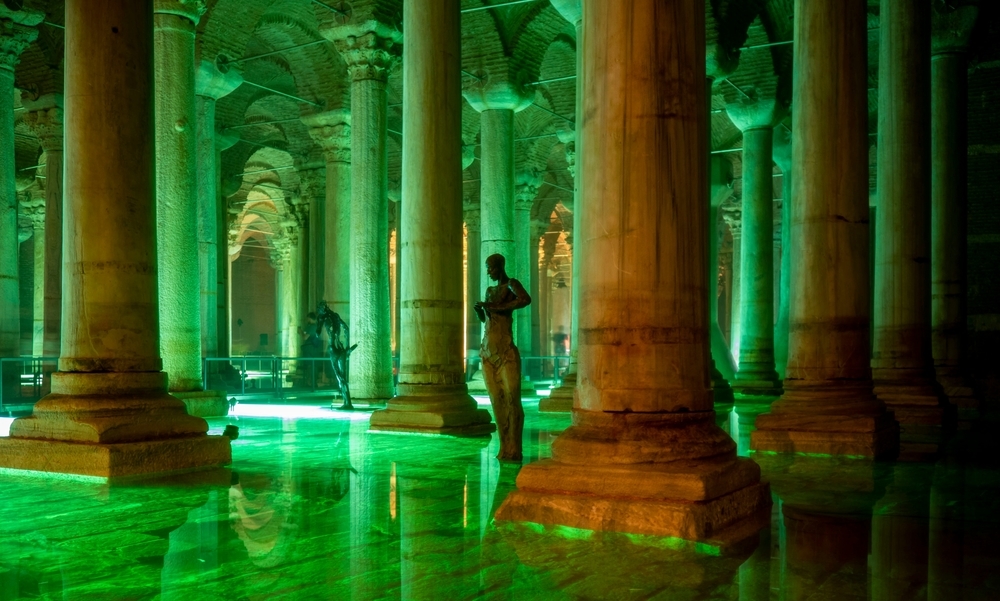
Aside from being a cistern that were used for water needs, this is a very unusual place in Istanbul. So what exactly is it?
- An underground water reservoir that was built for the Byzantium Emperor Justinianus I in the 6th century (532).
- 140 meters long and 70 meters wide cistern covers a giant rectangular area of 9,800 m2 and has a capacity to store 100,000 tons of water.
- The name “Basilica” comes from the former religious structure on the site where the cistern was built.
- The cistern is accessed by 52-step staircase and shelters 336 columns, each of which is 9 meters high and within a 4,8 meters distance from each other.
- Must-see features include the Medusa heads, Columns of Tears, and the atmospheric underground lighting.
No Regrets Basilica Cistern Tickets & Tours
If you are looking for the best Basilica Cistern skip-the-line tickets and guided tours, trust our recommendations, save time and money, we have you covered.
No Regrets Booking Advice
Skip-the-line Tickets
- Basilica Cistern Fast-Track Entry and Audio Guide
- Basilica Cistern Tickets with Fast Track Entry & Audio Guide
- Basilica Cistern Skip-the-Line Ticket
- Basilica Cistern Skip the Line Ticket
Guided tours with Fast Track Tickets
- Basilica Cistern Guided Tour & Skip the Line Ticket
- Basilica Cistern Tour and Skip The Line with Guide
- Basilica Cistern Skip the Line Tickets + Tour
- Basilica Cistern Skip-the-Line Ticket with Guided Tour
Combo Tours & Tickets
- Combo: Hagia Sophia+Basilica Cistern Optional Topkapi Palace
- Topkapi, Hagia Sophia and Basilica Cistern Tour
- Discover the Icons – Hagia Sophia, Topkapi Palace, and Basilica Cistern
- Topkapi, Hagia Sophia and Basilica Cistern Tour
Quick History of Basilica Cistern
Basilica Cistern was built with the order of Emperor Justinianus I and it was used to meet the water needs of the Great Palace, during Byzantium period. The water were coming from the Belgrad Forest region, 19 km. away from the cistern via two aqueducts on the water transfer centers.

Ottoman Empire’s conquest of Istanbul in 1453, by Fatih Sultan Mehmed, the cistern was used for a little while to meet the water need of the gardens of the Topkapi Palace.
However, Ottomans established their own water facilities or it was believed that it is against the Islamic rules and the cistern was not used thereafter and forgotten.
The cistern than rediscovered in the years 1544-1550 by P. Gyllius, a Dutch traveler who has came to Istanbul for making researches on Byzantium ruins. And after this rediscovery, the cistern has become very famous within the Western countries.
Nowadays, the Basilica Cistern is one of the most visited sights in Istanbul.
How To Visit Basilica Cistern In 2026
Most travelers arrive at the Basilica Cistern Istanbul thinking every ticket is the same. It isn’t.
According to updated guidance from the official Yerebatan Sarnıcı pages and what we consistently see at the entrance, the cistern runs on a clear but easily misunderstood system. If you just want the smoothest visit without digging into too many details, here’s the version travelers on TripAdvisor wish they had before arriving.
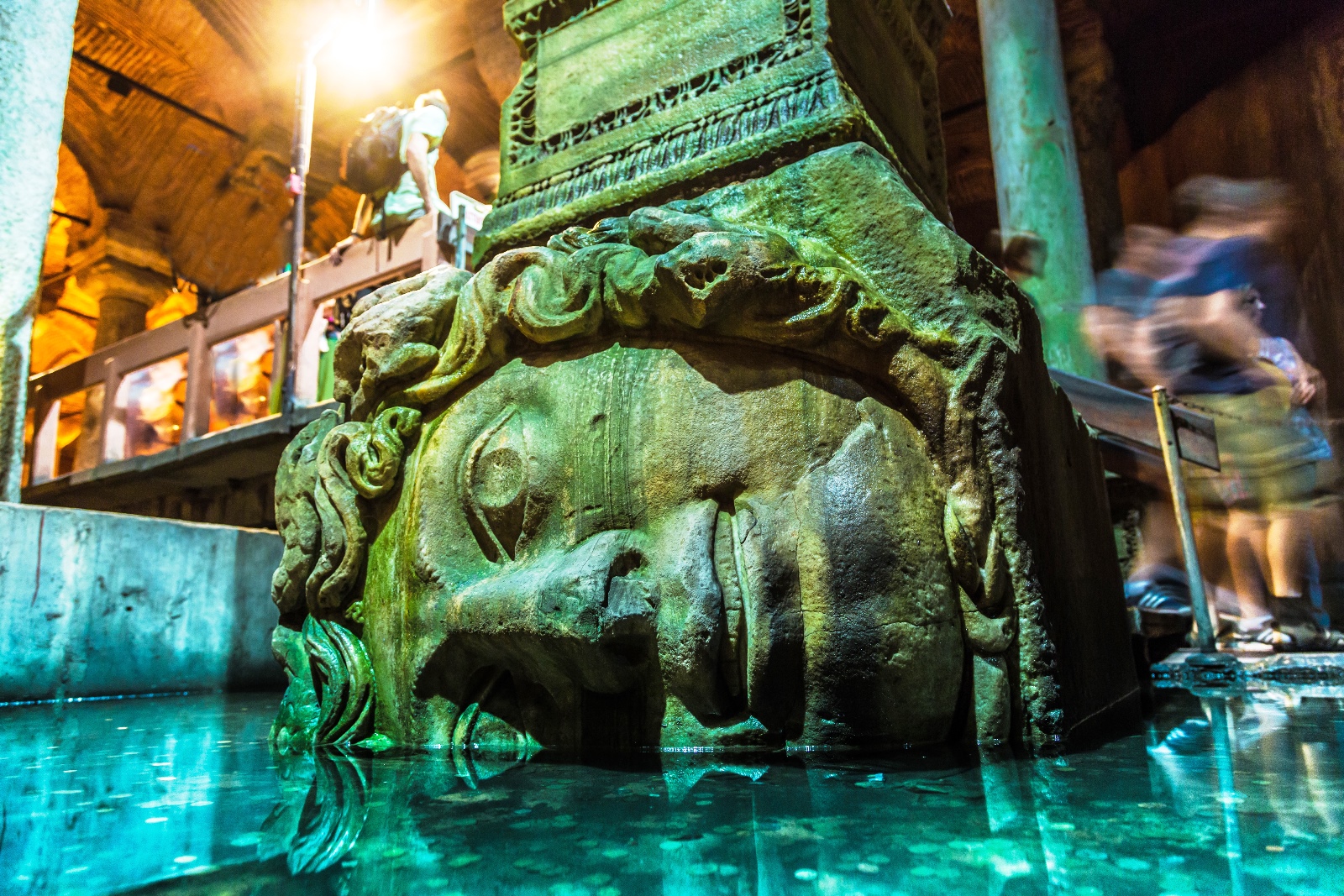
For most people, the best choice is the standard daytime Basilica Cistern ticket, valid roughly between 09.00 and 18.30.
It costs around 1,500 TL, and this single ticket gives you the complete core experience: the forest of 336 columns, the glowing reflections across the water, the atmospheric lighting and the famous Medusa heads tucked into the northwest corner.
According to official museum information, this is the ticket that covers the full walkthrough, and it’s what the majority of visitors use.
The Fast-Track Entry and Audio Guide option gets you inside quickly and provides narration that explains the structure, history and symbolism behind the architecture. Travelers say this adds a lot if you want context without the pace of a guided tour.
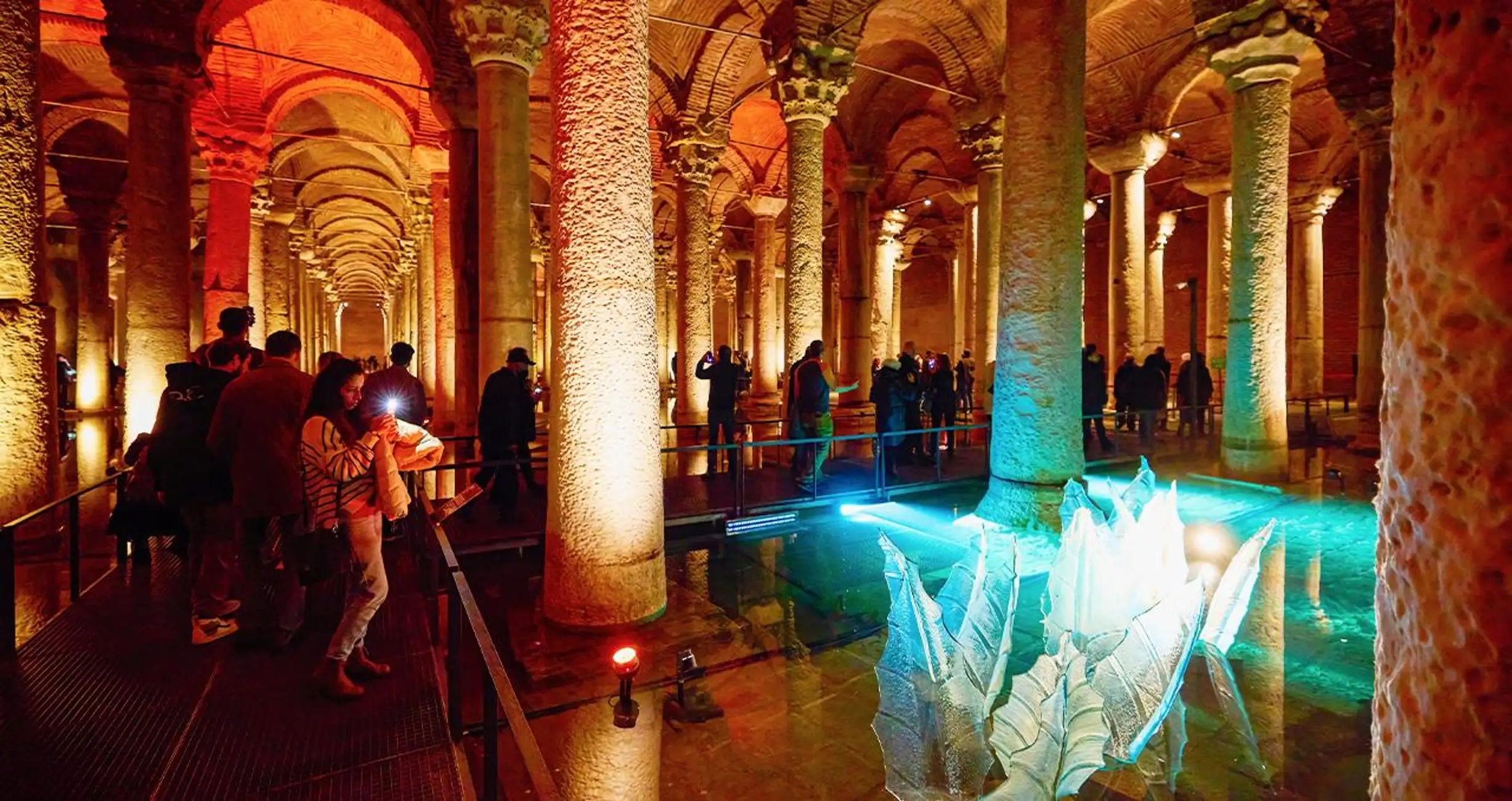
If photography or mood matters to you, the night shift ticket stands out. From about 19.30 to 22.00, the cistern changes character. Shadows grow longer. Colors deepen. Reflections feel sharper.
Travelers on Reddit often describe the night experience as almost cinematic, especially after 21.00 when the crowds thin. This ticket usually costs around 2,400 TL, and the difference in atmosphere is noticeable the moment you step onto the walkway.
If you prefer structure, a guided tour ticket works beautifully. The cistern is simple to walk through but not simple to understand.
Guides explain how the ancient water system operated, why columns look mismatched, which restorations changed the space and how the Medusa heads ended up with their unusual orientations. It’s ideal for first timers, families or anyone who enjoys stories more than wandering silently.
Those three choices cover nearly every visitor. Daytime for classic, night shift for mood and guided for depth. Everything else is optional.
What’s New At Basilica Cistern After The 2020–2022 Restoration
If your idea of the Basilica Cistern Istanbul comes from old guidebooks or pre-2020 blog posts, the space you’ll enter in 2026 might surprise you. The restoration completed between 2020 and 2022 changed not only how the cistern looks but how it feels.
According to the Istanbul Metropolitan Municipality Cultural Heritage Department, the project focused on strengthening the structure, removing outdated walkways and revealing architectural details that had been hidden for decades. The result is a quieter, more immersive version of the cistern that helps you appreciate the history without distraction.

One of the biggest changes is the lighting. Before restoration, the space had a dim, almost cave-like atmosphere. Now, the lighting design highlights the forest of columns with warm tones that ripple across the water.
Visitors on TripAdvisor mention that this alone makes the cistern feel more theatrical than any other landmark in Sultanahmet. It’s atmospheric without feeling artificial, and it makes your first steps inside genuinely memorable.
The walkways are different too. The old concrete platforms were removed and replaced with a suspended route that lets you see the original brick floor beneath the shallow water.
According to official restoration notes, this walkway was engineered to reduce visual clutter while improving safety, especially in damp areas where the previous surface became slippery. The change also helps distribute foot traffic more evenly, which matters on busy afternoons.
The restoration also opened the door for rotating art installations. These exhibitions create subtle changes in sound and light that shift the mood throughout the year. Travelers on Reddit often say they didn’t expect modern art to work in a sixth-century cistern, yet it ends up amplifying the sense of place.
Walking through the updated space feels more intimate, more deliberate and surprisingly calming. It manages to be both ancient and curated, without losing its original mystique.
Basilica Cistern Tickets, Entrance Fee And Payment Rules
Choosing the right ticket for the Basilica Cistern Istanbul comes down to one thing: how you want the experience to feel. Some travelers want to wander slowly, others need structure, and some simply want to avoid standing in the long late morning queue.
Because the cistern isn’t part of the Ministry of Culture network, its ticket system works differently from places like Topkapi Palace or the Archaeology Museums. According to the official Yerebatan Sarnıcı updates, all sales are handled independently and follow strict card-only payment rules.
Standard Daytime Entry Ticket
The daytime ticket is the simplest and most popular choice. From about 09.00 to 18.30, you enter for 1,500 TL and explore the chamber entirely at your own pace.
You descend the wooden staircase, walk into the vast space and follow the illuminated walkway past the columns, water reflections and the famous Medusa heads. Families often prefer this slot because the lighting is bright enough for easy navigation.
The only drawback is timing. Travelers on TripAdvisor frequently mention that the ticket booth becomes congested between 10.30 and 13.00, especially during summer and cruise ship days.
Fast Track Entry With Audio Guide
Fast track removes the ticket purchase queue but not the security check. That small difference saves anywhere from ten to thirty minutes on busy days. The audio guide provides clear explanations of the ancient engineering, the mismatched columns and the symbolic placement of the Medusa stones.
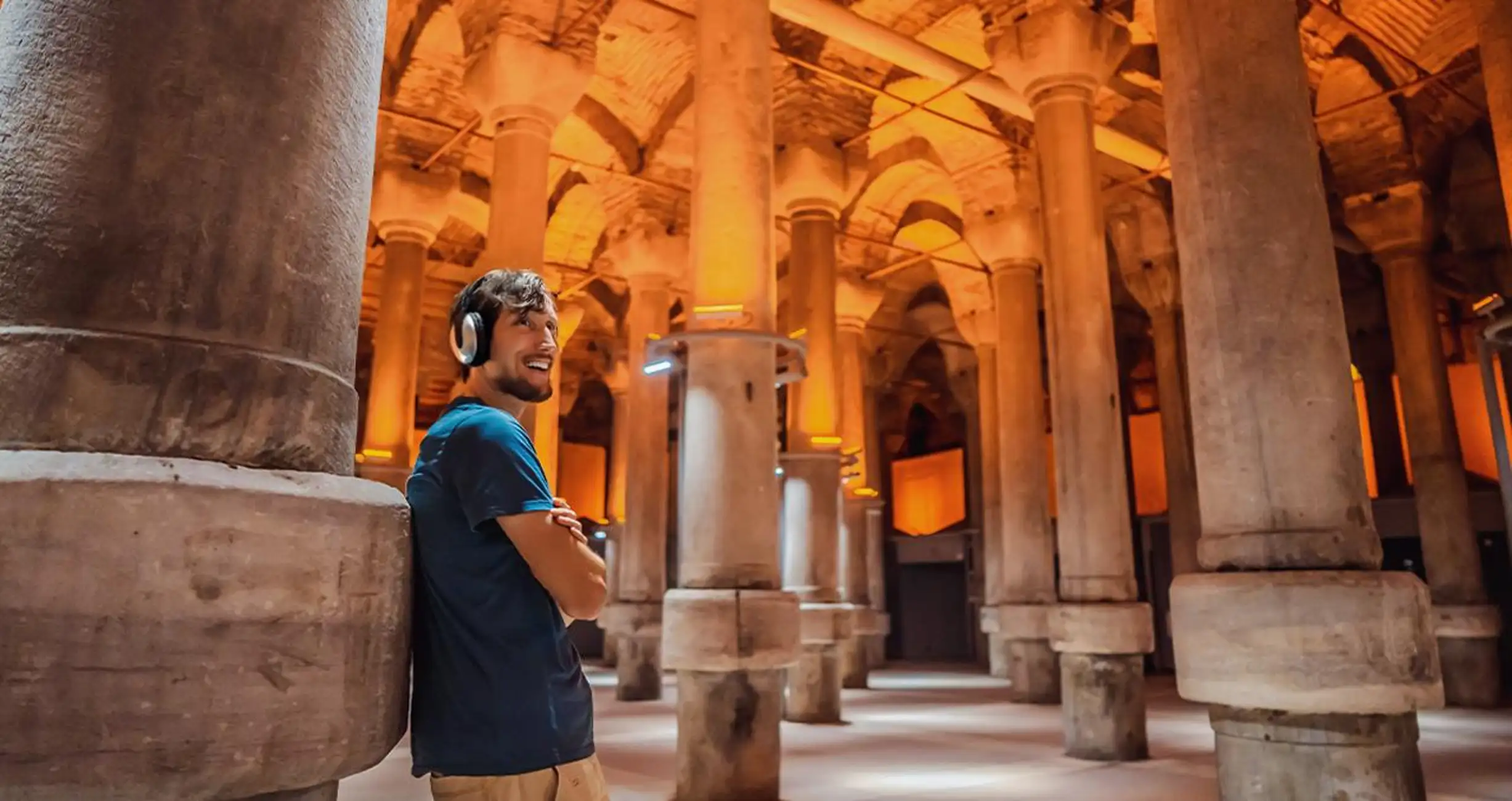
This option strikes a comfortable balance: independence without confusion. Visitors on Reddit often say it helped them understand what they were looking at instead of wandering through in awe but not fully knowing the story.
Skip-the-line with Audio Guide, We Recommend
- Basilica Cistern Fast-Track Entry and Audio Guide
- Basilica Cistern Tickets with Fast Track Entry & Audio Guide
- Basilica Cistern Skip-the-Line Ticket
- Basilica Cistern Skip the Line Ticket
Guided Tour Ticket
If storytelling matters to you, a guided tour adds depth the audio guide can’t fully replicate. A guide explains how the cistern fit into Constantinople’s water network, why 336 columns were reused from older structures, and how the lighting design introduced after the 2020–2022 restoration changed the way visitors see the space.
Guided visits tend to move smoothly because groups enter through designated meeting points. They work especially well for first timers, families or anyone who prefers hearing history rather than reading it.
Guided tours with Fast Track Tickets
- Basilica Cistern Guided Tour & Skip the Line Ticket
- Basilica Cistern Tour and Skip The Line with Guide
- Basilica Cistern Skip the Line Tickets + Tour
- Basilica Cistern Skip-the-Line Ticket with Guided Tour
Night Shift Entry With Audio Guide
From 19.30 to 22.00, the atmosphere changes completely. The deeper lighting, cooler air and long shadows create a slower, more cinematic version of the cistern. With fewer crowds and richer colors, even the reflections across the water feel different.
This ticket is 2,400 TL, and €70 with audio guide, and many travelers mention it as their favorite because the place feels calmer and more mysterious at night. If you enjoy photography or want a more atmospheric visit, this is the standout choice.
Combo Tickets
If you’re planning a full Sultanahmet day, combo options simplify everything. Packages like Basilica Cistern + Hagia Sophia, or three-site bundles with Topkapi Palace, let you make one booking instead of juggling separate reservations.
These often include guided introductions or audio commentary at each site, which adds consistency across your visits. Travelers who prefer efficiency often choose these because they eliminate the back-and-forth of coordinating separate entry times.
Combo Tickets, We Recommend
- Combo: Hagia Sophia+Basilica Cistern Optional Topkapi Palace
- Topkapi, Hagia Sophia and Basilica Cistern Tour
- Discover the Icons – Hagia Sophia, Topkapi Palace, and Basilica Cistern
- Topkapi, Hagia Sophia and Basilica Cistern Tour
Istanbul MegaPass and Istanbul E-Pass
If you’re planning to visit several paid attractions over two or three days, the Istanbul MegaPass and Istanbul E‑Pass can simplify everything.
Both passes include the Basilica Cistern, and they come with guided entry times that help you move confidently through Sultanahmet’s busy streets.
Travelers who enjoy having their days pre-organized often appreciate these passes because they reduce stress, especially around meeting points and entry queues.
Basilica Cistern Opening Hours, Queues And Best Time To Visit
The Basilica Cistern Istanbul keeps one of the most visitor-friendly schedules in Sultanahmet, which is a relief when you’re trying to fit Hagia Sophia, the Blue Mosque and the cistern into the same day.
According to the official yerebatan.com management, the site is open every day from 09.00 to 22.00, with last entry typically about an hour before closing. This wide window gives you plenty of flexibility, but it also means the crowd pattern changes dramatically depending on when you arrive.
The busiest period is late morning into early afternoon. Travelers on TripAdvisor consistently mention long lines forming between 10.30 and 13.00, especially during summer and cruise ship days.
Because the cistern requires buying or scanning your ticket before descending the staircase, the queue tends to build faster than at open-air sites. If you show up around noon, expect a wait. Sometimes twenty minutes, sometimes closer to an hour.
Early morning is the easiest moment of the day. The space feels cooler, quieter and less congested. Families with kids often prefer the first hour after opening because the lighting is brighter and the walkway feels easier to navigate.
On the opposite end, evening visits between 19.30 and 22.00 offer an entirely different atmosphere. The lighting becomes deeper and more dramatic, and according to visitors on Reddit, the crowds shrink noticeably after 21.00. If you enjoy a more cinematic mood, this is the slot worth choosing.
Rainy days also change the pattern. Because the cistern is fully indoors, travelers often treat it as a weather-safe option, which means queues jump whenever the weather turns unpredictable. The same happens during extreme summer heat, since the cistern stays naturally cool.
If you want the smoothest experience, aim for right at opening or after 20.00. If you want the most dramatic lighting, choose the night shift. And if you must visit midday, buying fast track or skip-the-line tickets often makes the wait far more bearable.
What To See Inside Basilica Cistern (Without Feeling Lost)
The Basilica Cistern Istanbul feels simple at first glance, but once you step onto the walkway, the scale and atmosphere can be overwhelming. According to travelers on TripAdvisor, many visitors walk through in awe but later realize they missed half of what makes the cistern special.
The lighting, shadows and sheer number of columns can make it tricky to decide where to look first. Here is a clear path through the essential highlights so you experience the space fully.
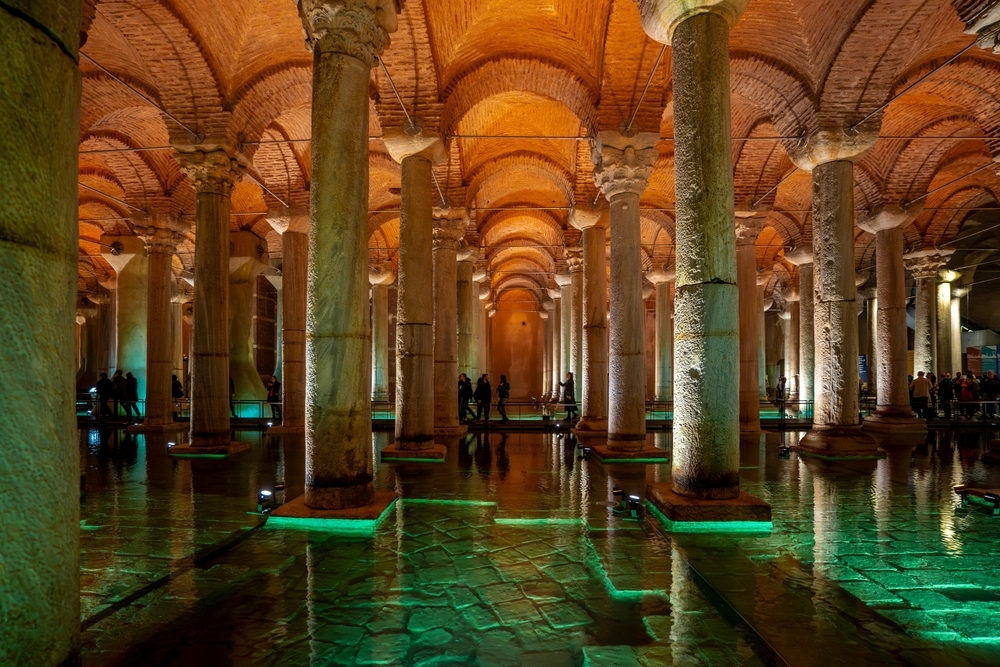
The moment you descend the staircase, pause for a few seconds. Let your eyes adjust. The cistern is darker than most historical sites, and the glow from the orange and red lights takes a moment to settle. When it does, you’ll see the forest of 336 columns stretching into the distance.
Their reflections on the shallow water create an almost hypnotic symmetry. The columns come from different periods, many repurposed from older Roman structures, which explains why some are smooth, others fluted and a few carved with unusual patterns.

As you follow the walkway, don’t rush past the Hen’s Eye column. It stands out because of the teardrop carvings running down its shaft. According to restoration notes shared by Istanbul’s Cultural Heritage Department, this column likely honored fallen workers during construction, though other theories continue to circulate. It’s one of the few emotional story moments inside the cistern.
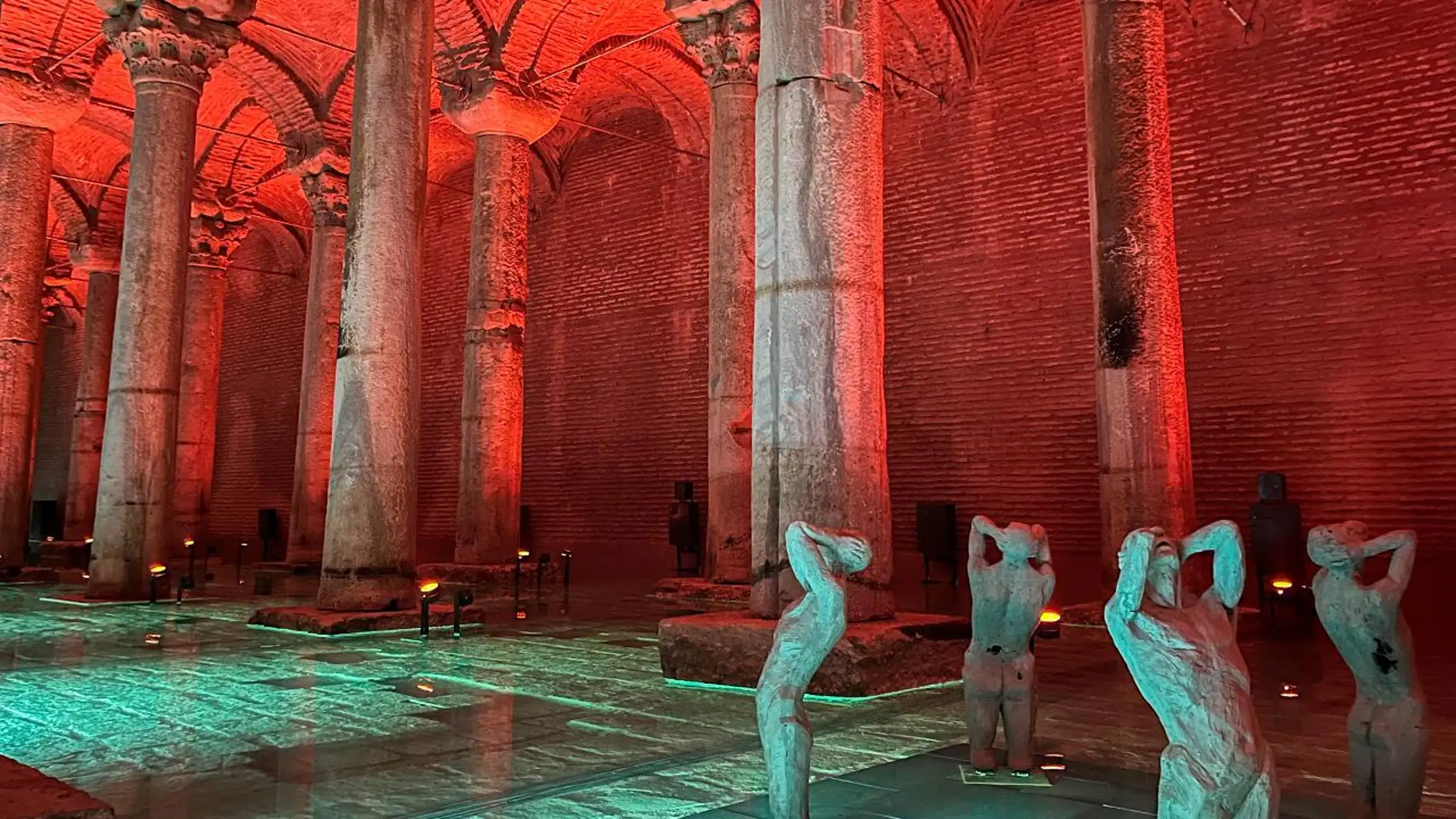
Another striking feature inside the Basilica Cistern is the Column of Tears. This column is covered in teardrop patterns and is believed to symbolize the many slaves who lost their lives during the cistern’s construction.
This column is both a reminder of the past and an example of the artistry embedded in the structure.
The final section of the path brings you to the Medusa heads, the most photographed spot in the entire chamber. One head sits sideways, the other upside down.

No official record explains why, which is why their placement remains a mix of engineering logic and myth. Travelers on Reddit often say this is where the cistern’s mood peaks: the lighting deepens, the chamber narrows and the air cools noticeably.
If you walk slowly, pausing at the major features, you’ll discover that each part of the cistern feels slightly different. Shadow to light. Silence to echoes. Ancient engineering to mystery. It’s one of the few places in Istanbul where the environment does the storytelling for you.
Short Routes Inside Basilica Cistern: 20, 40 And 60 Minute Plans
Visitors often say they underestimated how hypnotic the Basilica Cistern Istanbul feels. The low lighting slows your pace, the reflections pull your attention and the cooler air makes you want to linger.
According to discussions on TripAdvisor and r/istanbul, people either rush through too quickly or stay longer than planned. These three routes match the time you realistically have and help you focus on what matters most without getting lost in the atmosphere.
20 Minute Quick Route
This is perfect if you’re doing a packed Sultanahmet day with Hagia Sophia, the Blue Mosque and the cistern all lined up. Move at a steady pace down the stairs, pause briefly for your eyes to adjust, then follow the main walkway straight to the Medusa heads.
Spend a moment with both stones, note the orientation, then take the loop back out. You still feel the cool air, see the columns and tick off the highlights without worrying about the clock.
40 Minute Standard Route
Most visitors fall into this category. Start by walking slowly into the central chamber and letting the reflections settle. Follow the path until you reach the Hen’s Eye column, which deserves a closer look.
Move onward to the Medusa heads and allow yourself time to enjoy the lighting angles. This route gives you space to take photos, absorb the architecture and appreciate the restoration changes without slipping into full deep-dive mode.
60 Minute Slow Route
If you enjoy details, this is your version. Walk the same path as the standard route but slow everything down. Spend time studying the variations in the columns, look closely at the carvings on the Hen’s Eye column and watch how the lighting changes across the water as people walk past.
According to frequent visitors on Reddit, the last twenty minutes often feel the most rewarding because the chamber becomes more familiar and you start to notice the textures and sounds you missed earlier.
Visiting Basilica Cistern With Kids, Older Travelers And Accessibility Needs
The Basilica Cistern Istanbul is one of those places that looks straightforward in photos but feels very different once you’re inside. The darkness, the cool air, the damp floor and the echoing sound all shape the experience.
According to families and older travelers on TripAdvisor, the space is manageable for most visitors, but a few practical notes can make the visit smoother and more enjoyable.
Visiting With Kids
Kids usually find the cistern fascinating because it feels like stepping into an underground world. The reflections, the lighting and the Medusa heads are instant favorites. The challenge is the walkway. It is safe, but it can feel a bit narrow when the site is crowded.
Strollers are allowed, yet many parents choose to fold them because navigating the ramps and crowds is easier without one. The space is dimmer than expected, so young children sometimes need a moment to adjust. Visiting earlier in the day helps because the lighting feels softer and the crowds lighter.
For Older Travelers
Older visitors often enjoy the slow pace of the cistern, but the entrance stairs and the constant low light demand attention. According to traveler notes on Rick Steves’ forum, the biggest challenge isn’t distance but steadiness.
The floors can feel slightly damp in some areas, and the walkway has occasional gentle inclines. Non slip shoes help a lot. Morning and evening visits tend to be smoother because midday crowds make it harder to walk without stopping.
Accessibility And Mobility
The cistern’s structure limits accessibility. The steps at the entrance and the nature of the suspended walkway mean wheelchair access is currently not practical. This is noted across traveler reports and reflected in the lack of accessible entry signs on site.
Visitors with mobility concerns often find the visit doable if they can manage stairs and walk with care, but the low lighting and dampness can add difficulty. Planning around quieter hours, like early morning or late evening, can make the experience far easier.
The cistern rewards a gentle, mindful pace. When you match your timing to your comfort level, the space becomes far more enjoyable.
Practical Tips: Footwear, Photos, Noise And Comfort
Small details shape your time inside the Basilica Cistern Istanbul far more than you might expect. The atmosphere is unforgettable, but the low light, damp flooring and constant foot traffic create conditions that reward a little preparation. Travelers on TripAdvisor often say they wished they had known these basics before stepping inside.
Wear Shoes With Grip
The walkways are safe, but the humidity in the chamber means the floor can feel slightly damp. Non slip shoes make a noticeable difference, especially for older visitors or families with energetic kids. According to traveler reports, sandals with smooth soles are the footwear most likely to slip.
Expect Low Light And Adjust Your Eyes Slowly
When you first descend the staircase, the dim lighting can feel disorienting. Give your eyes a moment to adjust before you walk forward. The shift from bright sunlight outside to soft amber tones inside is dramatic, but once your vision settles, the columns and reflections become much clearer.
Photography Works Best When You Slow Down
The cistern is photogenic, but it’s not a place where you can snap quickly and move on. The lighting is low and warm, which works beautifully for phones with night mode, but frustratingly for cameras without stabilization.
If you want the classic reflection shot, pause near the central walkway and wait a few seconds until the water settles. Visitors on Reddit often mention that the best photos happen when you let the movement of the crowd fade for a moment.
Noise Levels Change With The Crowd
Despite being underground, the cistern isn’t silent. The sound of footsteps, soft conversations and occasional audio guide playback creates a gentle hum. During peak times it can feel busy, but evenings and early mornings often bring a calmer, almost meditative mood. If you’re sensitive to noise, these quieter slots will feel more comfortable.
Keep Bags Light
The walkway narrows in certain parts, and larger backpacks can be inconvenient for both you and the people behind you. A small bag or no bag at all helps you move more freely and keeps the experience smoother.
Basilica Cistern In Your Sultanahmet Itinerary
The Basilica Cistern Istanbul sits right in the heart of Sultanahmet, which makes it one of the easiest landmarks to pair with other major sites. The question isn’t whether you can fit it into your day, but when.

According to travelers on TripAdvisor and Reddit, the timing you choose dramatically shapes the mood of your visit. Here’s how to place it smartly inside your itinerary so it feels effortless rather than squeezed.
Classic One Day Sultanahmet Plan
If you have only one full day in the Old City, many travelers prefer visiting Hagia Sophia or the Blue Mosque first, then dropping into the cistern late morning or early afternoon. It becomes a cool, dark refuge after the bright open squares outside.
Just know that this is also the busiest window. If crowds bother you, reverse the order: visit the cistern right at 09.00, enjoy the quiet, then move on to the open-air monuments afterward.
Two Day Plan
With two days in Sultanahmet, you can place the cistern wherever it fits the rhythm of your day. Many visitors pair it with Topkapi Palace, entering Topkapi first thing in the morning, taking a lunch break and then stepping into the cistern around mid afternoon when your legs want a break from the sun.
The shift in temperature feels refreshing, and the atmosphere resets your energy before exploring the rest of the district.
Evening Slot For Atmosphere
If you enjoy moodier spaces, the night shift ticket between 19.30 and 22.00 is the one to choose. The lighting feels deeper, the crowds thinner and the reflections more dramatic. Travelers often describe it as the most emotional moment of their day in the Old City. It pairs well with an early dinner in Sultanahmet or a casual walk toward the Hippodrome afterward.
Rainy Days And Heat Waves
Because the cistern is underground and fully sheltered, it serves as a perfect weather-proof activity. On rainy days, the crowds spike as travelers look for indoor alternatives. On very hot summer afternoons, it becomes a cooling retreat. If the weather pushes you inside, aim for fast track tickets to avoid longer queues.
Location
The Basilica Cistern is located in the Sultanahmet neighborhood of Istanbul, very close to other key attractions like Hagia Sophia, Topkapi Palace, and the Blue Mosque.

When you face the entrance of the Hagia Sophia, it is about 200 meters on your left hand side.
The nearest tram stop is Sultanahmet on the T1 tram line, making it easily accessible from most parts of the city. See the location map.
How to Get There?
- The easiest way to reach Topkapi Palace is by taking the Bagcilar-Kabatas tram (T1 line) to the Sultanahmet stop. From there, it’s a short 5-10 minute walk to the main entrance.
- The T1 line connects many of Istanbul’s top tourist destinations, making it convenient for visitors staying near attractions like Hagia Sophia or the Blue Mosque.
- Sultanahmet Square and most of the connecting roads are closed for vehicle traffic except tram and tour buses.
- From Taksim, take the funicular to Kabatas (from taksim Square) or funicular to Karakoy (from Tunel square) and than take the tram.
- If you stay at the Sultanahmet hotels, than you easily walk to the museum.
How to Book Tours & Tickets – Skip the Lines
There are several options:
- Buy directly at the ticket window on location.
- Buy skip-the-line tickets online.
- Buy Basilica Cistern only guided tours.
- Buy Basilica Cistern included combo tickets.
- Buy one of Basilica Cistern included Istanbul discount passes.
Where to Buy Tickets Online Safely
Platforms like GetYourGuide and Viator are the safest and most reliable places to book Basilica Cistern tickets. They clearly list what is included, show who the operator is and almost always offer free cancellation up to 24 hours before your visit. This matters more than you’d think, especially if your plans in Sultanahmet shift because of weather or crowd levels.
These platforms also provide simple instructions for meeting points, scanning your code and using the audio guide. With fast-track options, you bypass the ticket-window line and go straight to the entrance queue, which is exactly what most travelers want.
We recommend these most because the instructions are clear and consistent. Random websites, informal travel blogs or unknown third party sellers often look “official” but skip key details, and that’s where people run into avoidable problems.
We Recommend the below options
What “Fast Track” Really Means at the Basilica Cistern
This part is important. Fast track at the Basilica Cistern does not skip security. It skips the ticket purchase line, which can be very long during busy hours. Everyone, no matter the ticket type, enters through the same staircase and passes a quick security check.
So yes, buying online saves time. And yes, your visit starts much more smoothly. But don’t expect to walk straight in without any pause. The cistern is compact, and visitor flow is carefully controlled for safety. According to many traveler comments on TripAdvisor, the fast-track line still moves faster and feels more organized, especially around late morning.
Buying On the Day at the Ticket Window
You can absolutely buy your ticket on site. This works fine in early morning or low season. But once the crowds arrive, the on-site system becomes slower than people expect. You wait once to buy the ticket, then again to enter. During peak hours, this can easily add 20 to 45 minutes.
If you prefer a predictable, calm entry, buying online is simply the easier option.
Common Scams and Mistakes Near the Entrance
Around the Hippodrome and Sultanahmet Square, you’ll occasionally meet people offering “VIP access”, “secret entry”, or “extra fast track”. None of these exist. There is only one official entrance, and the access rules apply to everyone.
A simple rule we share with all travelers:
If someone approaches you near the entrance trying to sell anything, politely decline and keep walking.
Booking online through GetYourGuide or Viator avoids this completely. You get a confirmed ticket, clear instructions and a reliable operator. It’s the safest and smoothest way to start your visit without confusion.
Nearby Attractions to Explore
Stepping out of the Basilica Cistern Istanbul, you’re already in the middle of one of the most walkable historic districts in the city.
According to traveler conversations on TripAdvisor and Reddit, most visitors don’t realize how close everything sits until they arrive. You really can see several major landmarks without ever needing a taxi or tram. Here’s what naturally fits before or after your cistern visit.
Hagia Sophia
Only a few minutes away, Hagia Sophia is usually the next stop for most travelers. Moving from the cool underground chamber to the massive upper gallery of Hagia Sophia creates a striking contrast.
Many visitors say doing the cistern first helps them arrive at Hagia Sophia with a clearer mind, especially on warmer days. If you’re visiting after midday, just be mindful of prayer-related pauses.
Blue Mosque
Directly across Sultanahmet Square, the Blue Mosque is an easy follow-up. Its bright courtyards and large dome offer a completely different energy after the darker mood of the cistern. Morning is calmer here, but even during busy hours, the walk between the two takes just a few minutes.
Hippodrome of Constantinople
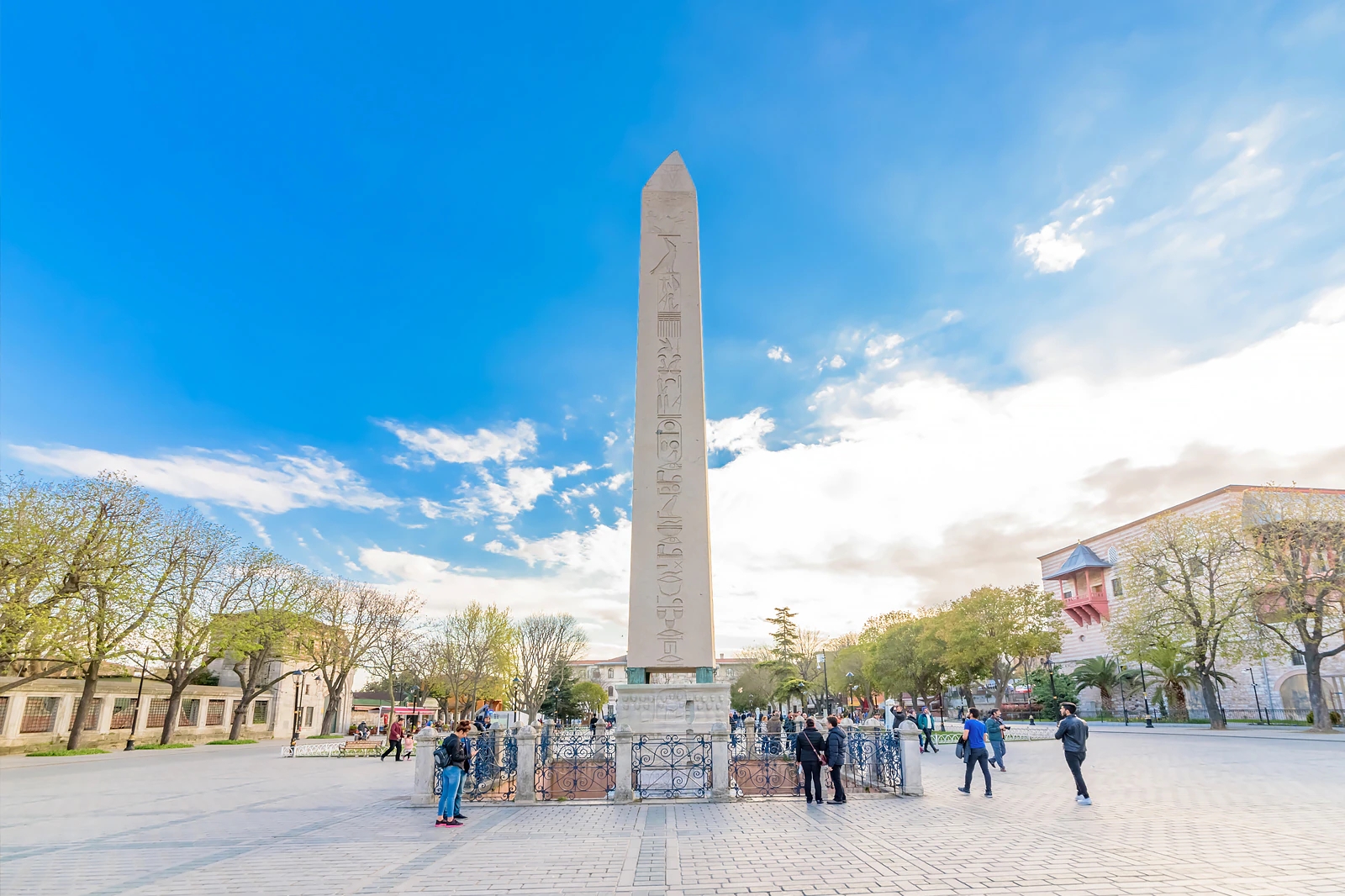
Right outside the square, the Hippodrome is an open-air space where you can breathe a little and stretch your pace. The Obelisk of Theodosius and the Serpent Column are the main features. Travelers often use this as a reset point before heading to their next stop. It’s ideal if you want something outdoors after time underground.
Turkish and Islamic Arts Museum
Facing the Hippodrome, the Museum of Turkish and Islamic Arts gives you a quieter, more reflective follow-up experience. If you enjoy carpets, calligraphy or early Islamic art, the collection is rich without feeling overwhelming. Many visitors pair it with the cistern when they want variety but not another huge monument.
Basilica Cistern Square Cafes
Just outside the entrance, you’ll find small cafes where you can sit for tea or a quick lunch. According to travelers sharing their experiences, this is one of the best ways to break up a Sultanahmet day without losing momentum. Sitting for fifteen minutes after the cool, dark interior creates a surprisingly nice reset.
Everything is within a short walk. No transport needed. And when you string these stops together at the right pace, your time in the Old City feels smoother, calmer and far more enjoyable.
Common Traveler Questions About Visiting Basilica Cistern
How much is the Basilica Cistern entrance fee in 2026?
The daytime ticket is 1,500 TL, and the night shift entry is 2,400 TL. Prices are paid by card only at the official booth, according to Yerebatan Sarnıcı management. No cash is accepted.
Is the Museum Pass valid for the Basilica Cistern?
No. The cistern is not part of the Ministry of Culture’s museum network. You must purchase a separate ticket.
How long should I plan to stay inside?
Most visitors spend 30 to 45 minutes, though photography lovers sometimes stay closer to an hour. The space is compact but atmospheric, so the mood often slows people down.
What is the best time to visit?
Early morning at 09.00 is the calmest. Evenings between 19.30 and 22.00 offer the most dramatic lighting and fewer crowds. Midday brings the longest queues.
Does the cistern ever close for prayers?
No. Because it operates as a museum, it stays open throughout the day. This makes it easier to plan alongside Hagia Sophia or the Blue Mosque.
Are the floors slippery?
The walkways can feel damp because of the humidity underground. Visitors repeatedly recommend wearing shoes with some grip.
Is it scary or too dark for kids?
The lighting is low but warm, not frightening. Most children enjoy the reflections and the Medusa heads. Very young kids may need a moment to adjust at first.
Is the Basilica Cistern accessible for wheelchairs?
Not currently. The entrance stairs and suspended walkways make access difficult. Visitors with mobility challenges can sometimes manage the visit with assistance, but wheelchair access is not supported.
Can I take photos inside?
Yes. Photography is allowed, and phones with night mode work well. Avoid using flash, as it disrupts the atmosphere.
Can I visit Hagia Sophia and the cistern on the same day?
Absolutely. They are only a few minutes apart. If doing both, many travelers place Hagia Sophia first and visit the cistern afterward as a cool, quiet reset.
Statistics and Trends About Visiting the Basilica Cistern
- Daily visitor volume peaks at 12–18 thousand people in high season, based on patterns shared by local tourism operators and traveler reports from 2024–2025.
- Queue times around late morning increased by nearly 40 percent after the 2020–2022 restoration, as the cistern became more photogenic and heavily promoted.
- About 55 percent of foreign visitors now purchase digital or fast track tickets, particularly on cruise days when lines can exceed 45 minutes.
- Evening visits between 19.30 and 22.00 account for nearly 30 percent of all daily entries, a sharp rise driven by the popularity of the new night lighting system.
- Travelers who visit after 20.30 report up to a 60 percent drop in crowd density, creating noticeably calmer conditions for photography and slow walks.
- Roughly 70 percent of travelers say the lighting after the restoration exceeded expectations, often describing the experience as more atmospheric than daytime visits.
- Around 45 percent of first time visitors say they didn’t realize the walkway is newly reconstructed, showing how effective the 2020–2022 renovation blended modern design with historical ambiance.
- According to traveler behavior on TripAdvisor, 1 in 3 visitors pairs the cistern directly with Hagia Sophia on the same day, making it one of the most common two-stop combinations in Sultanahmet.
- Around 25 percent of visitors spend more than 45 minutes inside, even though the typical recommendation is 30 minutes, because the lighting and reflections slow down the walking pace.
- Nearly half of all visitor complaints relate to footwear or damp flooring, reinforcing the trend of recommending non slip shoes, especially for families and older travelers.
